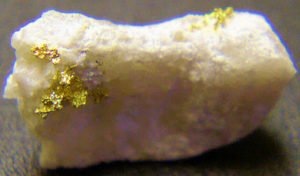California Mother Lode Prospectors
Exploration of gold in the hills of northern California.
From Wikipedia, the free encyclopedia:
In the United States, Mother Lode is most famously the name given to a long alignment of hard-rock gold deposits stretching northwest-southeast in the Sierra Nevada of California. It was discovered in the early 1850s, during the California gold rush. The California Mother Lode is a zone from 1.5 to 6 kilometres (0.93 to 3.73 mi) wide and 190 kilometres (120 mi) long, between Georgetown on the north and Mormon Bar on the south.
California Mother Lode Prospectors

California Mother Crystalline Gold
The Mother Lode coincides with the suture line of a terrane, the Smartville Block. The zone contains hundreds of mines and prospects, including some of the best-known historic mines of the gold-rush era. Individual gold deposits within the Mother Lode are gold-bearing quartz veins up to 15 metres (49 ft) thick and a few thousand feet long. The California Mother Lode was one of the most productive gold-producing districts in the United States. Now it is known as a destination for tourism and for its vineyards.
The California gold rush, as with most gold rushes, started with the discovery of placer gold in sands and gravels of streambeds, where the gold had eroded from the hard-rock vein deposits. Placer miners followed the gold-bearing sands upstream to discover the source in the bedrock. This source was the “mother” of the gold in the river and so was dubbed the “mother lode”.
Gold was discovered in California as early as March 9, 1842, at Rancho San Francisco, in the mountains north of present-day Los Angeles. Californian native Francisco Lopez was searching for stray horses and stopped on the bank of a small creek (in today’s Placerita Canyon), about 3 miles (4.8 km) east of present-day Newhall, California, and about 35 miles (56 km) northwest of L.A. While the horses grazed, Lopez dug up some wild onions and found a small gold nugget in the roots among the bulbs. He looked further and found more gold. Lopez took the gold to authorities who confirmed its worth. Lopez and others began to search for other streambeds with gold deposits in the area. They found several in the northeastern section of the forest, within present-day Ventura County. In November, some of the gold was sent to the U.S. Mint, although otherwise attracted little notice. In 1843, Lopez found gold in San Feliciano Canyon near his first discovery. Mexican miners from Sonora worked the placer deposits until 1846. Minor finds of gold in California were also made by Mission Indians prior to 1848. The friars instructed them to keep its location secret to avoid a gold rush.
+++++++
Be sure to view our Gold nuggets for sale.
View our Natural Silver specimens
Also see the most expensive type of gold nuggets, the Crystalline Gold Nuggets
Subscribe to our Youtube Arizona Gold Prospecting channel
2 Comments
big Airedale Terriers · April 27, 2022 at 1:41 pm
Enjoyed the read
San Diego DUI defense lawyer · March 9, 2022 at 5:36 am
Yes, still gold in California!